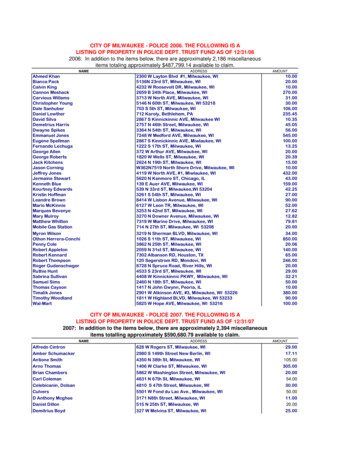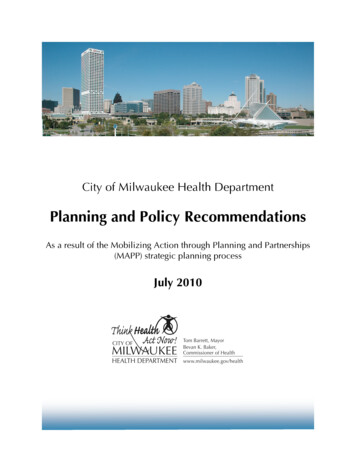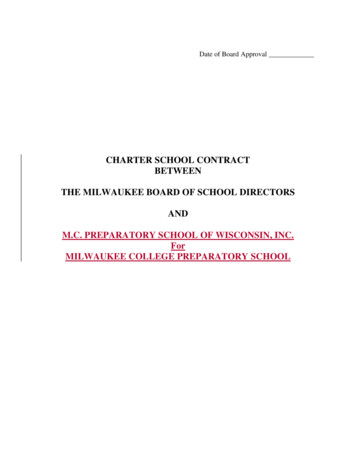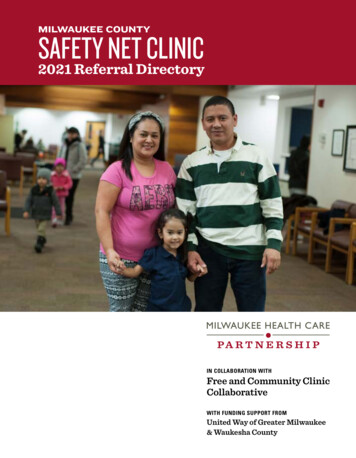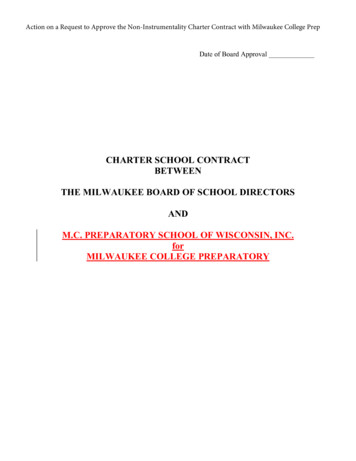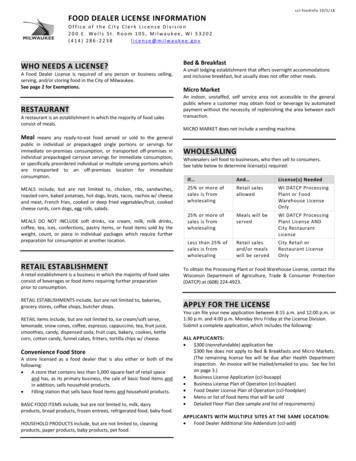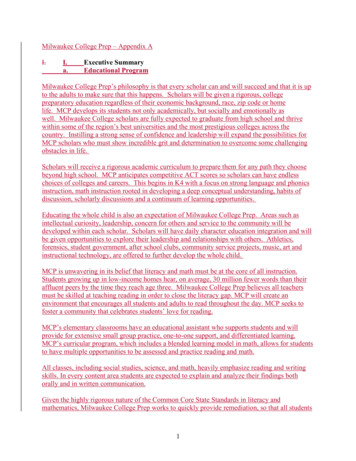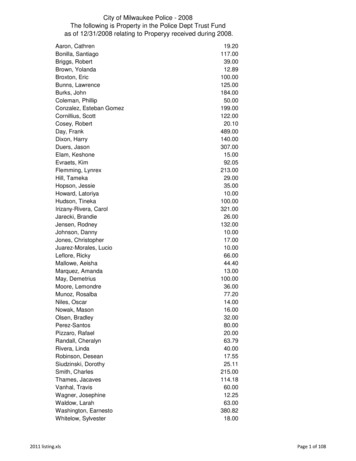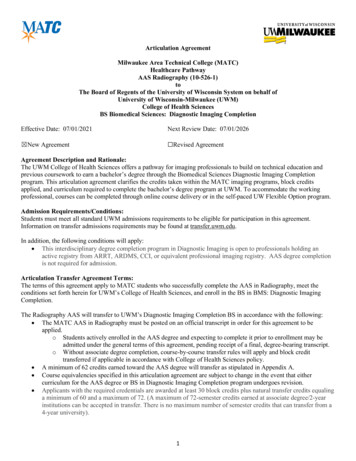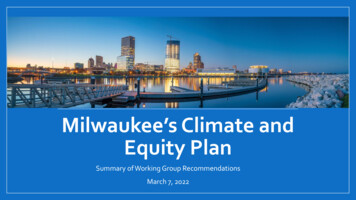
Transcription
Milwaukee’s Climate andEquity PlanSummary of Working Group RecommendationsMarch 7, 2022
Climate Threats: A Warming Planet 3 Big CausesOveruse of fossil fuels Deforestation Lack of sustained political action Threats Extreme Storms & FloodingHeat Waves and Urban Heat IslandsHealth risks, including asthmaWild Fires in the WestFood Supply DisruptionsClimate RefugeesNational SecurityLoss of BiodiversityMilwaukee Climate Vulnerability Reportavailable at Milwaukee.gov/ClimatePlan
2020: 22 weather events causing 1B in damage eachwww.ncdc.noaa.gov/billions/
Racial Equity: We’ve got work to doMilwaukee hasunacceptable racialdisparities in everyeconomic categoryincluding employment,incomes, homeownership, and energyburden.This is a city andmetropolitan ial-Equity/Data
City-County Task Force on Climate andEconomic EquityCommon Council established the Task Force in 2019 (CCFN190445) to address the ongoing climate crisis and mitigate racialand economic inequity through “green” jobs.Members Organizations Milwaukee Common Council Milwaukee County Board Citizen Action of WI Community Advocates Public PolicyInst. Milwaukee Area Labor Council Wisconsin Climate Table NAACP Sierra Club Clean Wisconsin Environmental Collaboration Office
Climate and Equity Plan GoalsMilwaukee.gov/ClimatePlan Reduce community greenhousegas emissions 45% by 2030 andachieve net zero emissions by2050 Improve racial and economicequity by creating green jobs thatpay 40,000 ; focus recruitmenton people of color
2020-2021 Progress Preliminary report published in March 2020 Greenhouse gas inventories completed for City of Milwaukeeand Milwaukee County Stakeholder working group met extensively throughout 2021to develop recommendations General public outreach including video surveys, onlinesurveys, presentations, and events Full report to be drafted in 2022, with additional communityengagement
Greenhouse Gas Emissions by Source - CO2e(ICLEI-USA Alternative Analysis)Process & FugitiveEmissions, 87,052 , 1%ResidentialBuildings,2,372,028 , 31%Industrial,1,689,465 , 22%Transportation,1,621,690 , 21%CommercialBuildings,1,689,465 , 22%Water andWastewater,22,282 , 1%Solid Waste,142,044 , 2%City of Milwaukee 2018Emissions 7.7 Million Metric Tons ofCO2-equivalents
Good News:We are not starting from scratch 2013 ReFresh Milwaukee SustainabilityPlan 2019 Green Infrastructure Plan Existing climate programsMe2 Home Energy Efficiency ProgramMilwaukee Shines Solar ProgramSustainability practices in city and countyoperations Multi-Modal Transportation New climate commitments fromcorporations, including We Energies
Milwaukee Climate and Equity Video /fb6e6ec84a
10 Big IdeasGreen and Healthy HomesElectric Vehicle InfrastructureCommercial Building EnergyBenchmarking Reducing Vehicle Miles TraveledNet Zero Energy New HomesGreening the GridGreen Jobs AcceleratorNature in the CityReducing Food WasteResilience Ambassadors
Process Notes Nine working groups developed thorough recommendations and lengthyPowerPoints to describe each proposal in detail. What follows is a summary. All of the working groups understand and accept the fiscal constraints that theCity has. However, they were instructed to “think big” to position Milwaukee forfederal grants and other funding opportunities that are now available to meet thegoals established by the Common Council and County Board. We are in the process of hiring a consultant that will provide additional analysisand turn the working group recommendations into a cohesive document
Green Jobs AcceleratorBackground Long-standing racial inequities in number ofjobs and household incomesRecommendations Clarify pathways & build excitement for green jobs Training with supports (including CDL, OSHA-30,basic construction courses, and skilled tradestraining through registered apprenticeships)Transitional jobs with career ladders Good paying job opportunities in the tradesand other “green jobs” Existing training providers include unions,MATC, MREA, and others. Highest paying jobsrequire most time and training, e.g.Electricians and Building Automation DPW currently struggling to recruit and retainqualified trades people, a problem madeworse by the pandemic Community benefits agreements for publiclyfunded projects MOUs with employers for EDI goalsNeed to scale up now to prepare for majorfederal infrastructure investments Support black and brown employers and fosterbusiness development EDA grant application proposed creating 85 GreenJobs Trainees and Apprentices in DPW, with driverinstructors
Green and Healthy HomesMaking existing homes more energy efficientBackground High “energy burden” in low-income andneighborhoods of color Opportunity to help people where they live Older housing stock has lots of challenges,with different government programs to fixdifferent things with different eligibilitycriteria More can be done to reach tenants Existing programs include WeatherizationAssistant Program (WAP), Me2, and Focus onEnergyRecommendations Support holistic approach to housingrenovations: coordinate lead abatement,energy efficiency, and other healthy homeimprovements Streamlined system and tools to help residentsnavigate and enroll in housing programs Fund and enhance Me2 program andWeatherization Assistance Support contractor and workforcedevelopment Develop strategy to begin replacing gas heatand appliances with electric, including coldclimate heat pumps
New Net Zero Energy HomesBackgroundRecommendations Labor productivity in construction hasdeclined since 1968, in contrast to otherindustries; we are facing shortages in skilledtrades and affordable housing unitsAttract “off-site” building systemmanufacturer e.g. construct completewall systems in a factory setting, whichcan be assembled into homes on vacantlots. New homes designed for durability,affordability, and high energy efficiencystandards Need for manufacturing jobs in Century City Mismatch in cost of new construction versusexisting home values leads to mortgagefinance limitations on new homeconstructionARPA funding and ECO efforts haveidentified a firm that is working onfinancing options for Century City Supports CDA’s Housing Plan The City of Milwaukee has approximately1,750 buildable vacant lots scatteredthroughout neighborhoods suitable forsingle-family or duplex development
Commercial Building Benchmarkingand Building Performance StandardsBackground Commercial buildings include office buildings andcommercial space, as well as multi-family apartmentbuildings with more than 4 units. State of Wisconsin controls the building code Since 2012, the City of Milwaukee has championed theU.S. Department of Energy’s Better Buildings Challenge,with voluntary participation of 133 commercialbuildings in the city Recommendations supported by leading nationalclimate policy organizations including by ICLEI-USA,IMT, ACEEE, USGBC Mayor Johnson joined the Building PerformanceStandard Coalition, a White House CEQ led effort of over30 states and local governments to implement buildingperformance standard policies by Earth Day, 2024Recommendations Establish a Commercial Building EnergyBenchmarking ordinance (annualenergy reporting) Phase in a Building PerformanceStandard that requires buildings to meetgreenhouse gas reduction targets overtime Stakeholder engagement process withequity lens to refine a specific policy Advocate with the State of Wisconsin toadopt the international model energycode without weakening amendments Scale up energy efficiency work inmunicipal buildings
Reduce Vehicle Miles TraveledBackgroundRecommendations1. TransitExpand Bus Rapid Transit (7 new routes proposed bySEWRPC) Streetcar expansion; better coordination with County Improve existing route frequency and facilities Prosperous cities and neighborhoods featuremixed uses, vibrant streets, and are safe forpedestrians and bicyclists Designing cities around car travel andhighways have contributed to populationdeclines, high-speed reckless driving,disconnected people from jobs, and createdthe economic burdens of car ownership2.Inequitable transportation access results froma legacy of discriminatory housing, land useand transportation policies that this plan seeksto address.3. Active Modes (Walking and Biking) 30th Street Corridor Trail projectProtected bike lanesMajor design changes to 27th St., Fond Du Lac Ave.,Capitol Dr., 35th St.Land Use & Zoning Less Parking; More Transit-Oriented DevelopmentUpdate zoning code to increase density (e.g. allowaccessory dwelling units); eliminate parking minimumson developmentAdvocate State to allow for inclusionary zoning laws
Electric VehiclesBackgroundRecommendations Achieving “mode shift” to walking, bikingand public transit depends on long terminfrastructure and land use changes, andwill take substantial time. Develop and adopt a formal chargingnetwork plan for deploying an electricvehicle charging network, includingmunicipally owned stations. The bipartisan infrastructure bill allocates 7.5 billion to build EV chargingnetworks. EV’s have no tail-pipe emissionsBy 2023, develop a city ordinance thatrequires EV charging infrastructure atparking lots, multi-family residentialbuildings, mixed use developments andother commercial properties. Without intervention, 34% of new lightduty vehicle sales are projected to beelectric by 2030Advocate for supportive EV policies withState of Wisconsin and utilities 50% of new sales should be EVs with betterinfrastructure
Greening the Grid(Renewable Energy)BackgroundRecommendations 25% by 2025 renewable energy goal for city buildings The City of Milwaukee and Milwaukee County are in WeEnergies service territory. We Energies is the sole publicelectric utility in our area. They are regulated by the PublicService Commission of Wisconsin.Support 1) robust and competitiverooftop solar market and 2) utility-scaleinvestments in renewable energy Advocacy at State through WisconsinLocal Government Climate Coalition anddirect intervention on PSC cases Purchase 25% to 100% of the City’smunicipal electric needs from WeEnergies through new proposed“Community Energies” program (DRERalternative) Fuel mix is still mostly coal and gas, but renewables aregrowing Current state and utility policies regarding rooftop solarlag other states We Energies announced plans to eliminate coal by 2035and be carbon neutral by 2050 A greener grid underpins other strategies like beneficialelectrification for vehicles and buildings
Protecting and Restoring Nature inthe CityBackgroundRecommendations Trees remove carbon dioxide fromatmosphere and create oxygen Protect Environmentally Sensitive Lands(including areas along lakes and rivers) Excessive amounts of pavementcreate urban heat islands, increaseflood risk, and reduce biodiversity Expand the Green and Healthy SchoolyardRedevelopment Program Less tree canopy in communities ofcolor Implement the Branch Out MilwaukeeCampaign City adopted a Green InfrastructurePlan in 2019 Green-Cooling Commercial Lots
Food Waste ReductionBackground Food and organic materials thatdecompose anaerobically in landfillscreate methane, a powerful green housegasRecommendations FEED Milwaukee Collaboration Food insecurity and health problemsrelated to food are an equity concern. US EPA’s “Food Recovery Hierarchy”prioritizes preventing and divertingwasted food 15% of waste in SE Wisconsin is foodaccording to DNR FEED “Food Excess Equitable Distribution” torescue surplus food and distribute it to hungrypeopleContinue and evaluate Milwaukee’s Fresh FoodAccess FundIdentify barriers and opportunities for fooddonation, handling, and distribution, includingapps to connect people and foodDevelop reusable food service containersystem (to wash and reuse takeoutcontainers) community-wide composting
Resilience AmbassadorsRecommendationsBackground How do we prepare residents forclimate change impacts that arealready happening? Risks: Flooding, Heatwaves, extremecold. MMSD Resilience Plan ECO EPA Environmental JusticeGrant Work with trusted messengers toconnect residents with resiliencyresourcesCity’s housing programs, including leadabatement, energy efficiency, and otherprograms MMSD Pipe Check program City anti-displacement programs Prioritize flood-prone neighborhoods &review floodplains for bigger storms Resiliency hubs
Many Strategies Needed1. Green the Grid: ReplaceCoal power plants withrenewable energy2. Energy Efficiency: Saveenergy through moreefficient homes,commercial buildings, andvehicles3. Electrification: Replaceheating and vehicle fossilfuel with electric4. Drive lessNote: Percentages will be refined with additionalanalysis
Communications and FinanceCommunications Goal: Informed, Connected, Engaged, &Inspired residents in all neighborhoods Three Part Plan1.2.3. Education/Communications CampaignOutreach through CBOs, neighborhoodgroups, and environmental organizationsActions and EventsCollaborative communication strategybetween government agencies and nonprofits that recognize their unique roles withcommon goalsFinance Build capacity (staff and/or contract grantwriters) to monitor and apply for millions ofdollars in federal grants Green and Healthy Homes Fund Ensure transportation funding supports climaterecommendations Climate Capital Campaign Whole-of-government alignment (e.g. assess forclimate impacts along with equity in financialdecisions) Green bonds, Energy Saving PerformanceContracts
Next Steps RFP for consulting firm has been issued Additional analysisDraft report and public-facing materialsFinal report drafting after additional public review FUSE Fellow to start in April to support additional public outreach on plan Scale up City’s grant-writing capabilities
and public transit depends on long term infrastructure and land use changes, and will take substantial time. The bipartisan infrastructure bill allocates 7.5 billion to build EV charging networks. V's have no tail-pipe emissions Without intervention, 34% of new light-duty vehicle sales are projected to be electric by 2030 .
